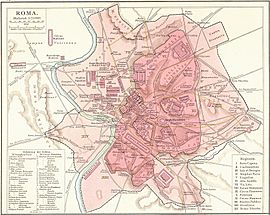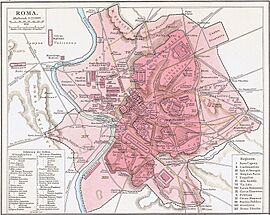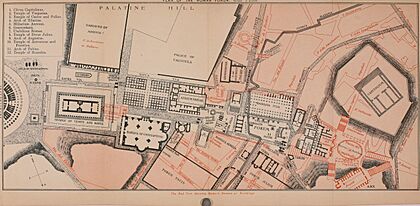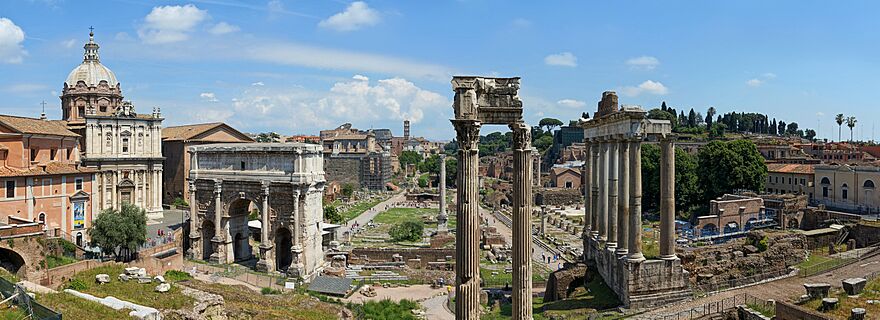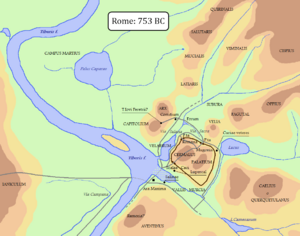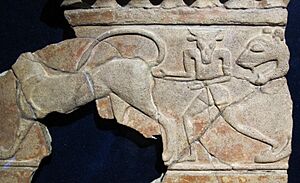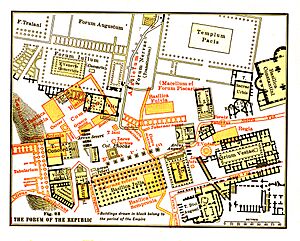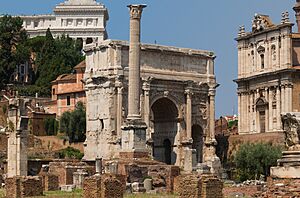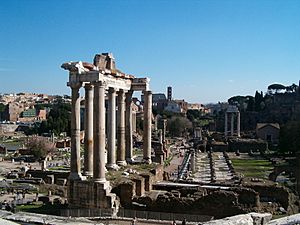Roman Forum facts for kids
|
Forum Romanum
|
|
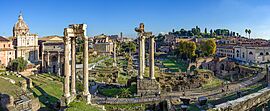
Surviving structures: Tabularium, Tarpeian Rock, Temple of Saturn, Temple of Vespasian and Titus, Arch of Septimius Severus, Curia Julia, Rostra, Basilica Aemilia, Forum Main Square, Basilica Iulia, Temple of Caesar, Regia, Temple of Castor and Pollux, Temple of Vesta, Rostra Augusti, Umbilicus Urbi, Milliarium Aureum, Lapis Niger, Basilica of Maxentius
|
|
| Location | Central Rome |
|---|---|
| Region | Lazio |
| Coordinates | 41°53′32″N 12°29′7″E / 41.89222°N 12.48528°E |
| Altitude | 13 m (43 ft) |
| Type | forum |
| Part of | Ancient Rome |
| Area | 2 ha (4.9 acres) |
| History | |
| Founded | 8th century BC – AD 608 |
| Abandoned | Largely neglected from the 8th century AD onward |
| Cultures | Roman Republic, Roman Empire |
| Site notes | |
| Condition | Most buildings in ruins |
| Public access | Yes |
| Architecture | |
| Architectural styles | Ancient Roman architecture, Paleochristian architecture |
The Roman Forum (Italian: Foro Romano), also known by its Latin name Forum Romanum, is a large open space in the middle of Rome. It is surrounded by the ruins of many important government buildings from ancient times. People in the ancient city called this area the Forum Magnum, which means "Great Forum," or simply the Forum. It was originally a marketplace.
For hundreds of years, the Forum was the heart of daily life in Rome. It was where victorious armies marched in parades called triumphs. People also voted for their leaders here. Important speeches were given, court cases were held, and even gladiatorial matches took place. It was also the main place for business and legal matters. Statues and monuments honored the city's leaders. Many people call it the most famous meeting place in history. Today, the Forum is a large area of ruins with many broken buildings. It attracts millions of visitors every year.
Many of Rome's oldest and most important buildings were in or near the Forum. The earliest shrines and temples of the Roman Kingdom were on its southeastern side. These included the Regia, an ancient royal home from the 8th century BC, and the Temple of Vesta from the 7th century BC. There was also the House of the Vestals, where priestesses lived. All these buildings were rebuilt after the Roman Empire began.
Other old shrines, like the Umbilicus Urbis and the Vulcanal (Shrine of Vulcan), were in the northwest. These areas grew into the Republic's official Comitium, which was an assembly area. This is where the Senate and the government itself started. Over time, the area became crowded with the Senate House, government offices, courts, temples, and statues.
Later, the old Comitium was replaced by the larger Forum next to it. Legal activities moved to the new Basilica Aemilia in 179 BC. About 130 years later, Julius Caesar built the Basilica Julia and the new Curia Julia. This moved the courts and the Senate back to the Forum. This new Forum became a lively city square where Romans gathered for business, politics, law, and religious events.
Eventually, much of the business and legal work moved from the Forum Romanum to bigger, fancier buildings to the north, like Trajan's Forum and the Basilica Ulpia. The reign of Constantine the Great saw the last major addition to the Forum, the Basilica of Maxentius in 312 AD. This brought the political center back to the Forum until the Western Roman Empire ended almost two centuries later.
Contents
What the Roman Forum Looked Like
Unlike later imperial forums in Rome, which were carefully planned, the Roman Forum grew slowly over many centuries. Even though leaders like Sulla, Julius Caesar, and Augustus tried to organize it, it developed bit by bit. By the time of the Roman Empire, large public buildings surrounded the main square. This made the open area about 130 by 50 meters in size.
The Forum stretched from the bottom of the Capitoline Hill to the Velian Hill. The large buildings called basilicas, like the Basilica Aemilia on the north and the Basilica Julia on the south, shaped its long sides. The Forum included this main square and the buildings facing it. Sometimes, it also included an extra area that went southeast to the Arch of Titus.
Originally, the Forum area was a marshy lake where water from the surrounding hills collected. The Tarquins drained this area using the Cloaca Maxima, a large sewer system. Over centuries, floods from the Tiber River and dirt washing down from the hills raised the ground level of the Forum. As the ground rose, people simply paved over the debris. The final travertine paving, which you can still see today, was laid during the time of Augustus. Excavations in the 1800s showed many layers of paving. The deepest level found was 3.60 meters above sea level, with signs of human activity like burned wood.
A very important use of the Forum, both during the Republic and the Empire, was for Triumphs. These were parades celebrating military victories. Generals who won battles would enter the city through the Triumphal Gate. They would walk around the Palatine Hill, then come down the Via Sacra into the Forum.
From there, they would go up the Capitoline Rise to the Temple of Jupiter Optimus Maximus on top of the Capitol Hill. After the ceremonies, big public feasts were held back in the Forum. Besides the Via Sacra, other famous roads like the Vicus Jugarius and Vicus Tuscus also led to the Forum.
The Forum's Long History
Early Beginnings (Before Rome)
Pottery found in the Forum, Palatine, and Capitoline Hills shows that people lived in these areas during the late Bronze Age (1200–975 BC). In the early Iron Age, around the 10th century BC, a part of the future Forum was used as a cemetery. This was likely by communities living on the Palatine and Capitoline hills. Most burials were cremations, where ashes were placed in jars with grave goods and buried. There were also a few burials where bodies were placed in the ground. Burials in the Forum likely stopped in the late 9th century BC.
The first archaeological finds of public buildings show that the Forum changed from a cemetery to a public space in the 8th century BC. Part of the Forum was paved. The earliest discoveries in the Comitium and Vulcanal areas were offerings. This suggests the area was used for religious ceremonies.
The Roman Kingdom Era
Stories from Roman History
Roman stories say the Forum began with an agreement between Romulus, Rome's first king, and his rival, Titus Tatius. They fought, but Sabine women stopped the battle. Since the valley was between their two settlements, it became their meeting place. The early Forum had swampy areas, so the easiest place to meet was the northern part, called the Comitium. It was here, at the Vulcanal, that they supposedly put down their weapons and formed an alliance.
The Forum was outside the walls of the original Sabine fort. These walls were mostly taken down when the two hills joined. The first Forum was an open-air market next to the Comitium. But it soon became too busy for just shopping. As political speeches, trials, and other public events grew, other markets appeared in the city for specific goods like cattle, pork, vegetables, and wine.
Rome's second king, Numa Pompilius (ruled 715–673 BC), is said to have started the worship of Vesta. He built her house and temple. He also built the Regia as the city's first royal palace. Later, Tullus Hostilius (ruled 673–642 BC) enclosed the Comitium around an old Etruscan temple. This is where the Senate would meet, near where the Sabine conflict happened. He is said to have turned that temple into the Curia Hostilia. In 600 BC, Tarquinius Priscus had the area paved for the first time.
What Archaeology Tells Us
The Forum was originally a low, grassy wetland. It was drained in the 7th century BC when the first parts of the Cloaca Maxima were built. This was a large covered sewer system that flowed into the Tiber River. More people were settling between the two hills at this time. By the end of the 7th century BC, the ground level of the Forum was raised in some places. This helped with drainage and provided a base for a paved area. Around the middle of the 7th century BC, old huts along the Via Sacra were taken down. Rectangular stone buildings began to replace them.
The earliest structures in the Forum were found in two spots. One was the Comitium area. The other was a group of holy places: the Regia (House of the kings), the House of the Vestals, and the Domus Publica. Around 650–630 BC, the Comitium area was dug out into a deep triangular shape. It was paved with packed earth, and later with gravel. Nearby was an old shrine to Vulcan called the Vulcanal. It was a small pit and oval basin carved from rock. The oldest items found there are from the second half of the 8th century BC. Romans seemed to know these sites were very old. They believed Romulus himself founded the Comitium and Vulcanal. The first Curia (senate house) was also nearby.
At the western end of the Forum, near the House of the Vestals and the shrine of Vesta, archaeologists found important buildings from the 7th century BC. These are thought to be early versions of the Regia, House of the Vestals, and Domus Publica (the official home of the chief priest). There was a lot of building in the Forum in the late 7th century BC, from 625 to 600 BC. In the 6th century BC, more paving was laid. Many pieces of terracotta decorations show that buildings around the Forum became more detailed and fancy.
The Roman Republic Era


During the Roman Republic, the Comitium remained the main place for all legal and political life. To make a larger gathering area, the Senate started to expand the open space between the Comitium and the Temple of Vesta. They did this by buying private homes and tearing them down for public use. Several consuls (Roman leaders) oversaw projects to repave and build on both the Comitium and the Forum.
The 5th century BC saw the first Forum temples with known building dates. These were the Temple of Saturn (497 BC) and the Temple of Castor and Pollux (484 BC). The Temple of Concord was added later, possibly by Marcus Furius Camillus. Speakers often gave speeches from the elevated platform called the Rostra. At first, speakers faced the Senate House, with their backs to the people in the Forum. But a tribune named Caius Licinius (consul in 361 BC) was said to be the first to turn and face the people in the Forum. Gaius Gracchus did this again two centuries later.
This started a tradition where even young nobles were expected to speak to the people from the Rostra. Gracchus was seen as changing old Roman customs. In 318 BC, Censor Gaius Maenius added balconies to buildings in the Forum area. These were called maeniana. Spectators could use them to better watch games held in temporary wooden arenas.
The benches for the Tribunes were also placed in the Forum Romanum. They were first next to the senate house. Later, during the late Republic, they were in front of the Basilica Porcia.
The first basilicas (large halls with aisles) were built in the Forum in 184 BC by Marcus Porcius Cato. This began the process of making the site more grand. The Basilica Fulvia was opened on the north side of the Forum square in 179 BC. It was rebuilt and renamed several times. Nine years later, the Basilica Sempronia was opened on the south side.
Many traditions from the Comitium, like public meetings, funerals for important people, and games, moved to the Forum as it grew. A notable change was the move of the comitia tributa, which was important for popular politics, in 145 BC. In 133 BC, the Tribune Tiberius Gracchus was killed by a group of senators there.
In the 80s BC, during the time of Sulla's rule, major work was done on the Forum. The plaza level was raised by almost a meter, and permanent marble paving stones were laid. This paving level stayed mostly the same for over a thousand years. It was only after Rome was attacked in 1084 that debris began to pile up.
In 78 BC, the huge Tabularium (Records Hall) was built at the Capitoline Hill end of the Forum. This was ordered by the consuls M. Aemilius Lepidus and Q. Lutatius Catulus. In 63 BC, Cicero gave his famous speech against the plotters of Catiline at the Forum. He spoke in the Temple of Concord, which was sometimes used by senators for meetings. After the verdict, the plotters were taken to the Tullianum, a nearby prison, for their punishment.
Over time, the Comitium was changed by the growing Curia and Julius Caesar's plans before he was killed in 44 BC. That year, two very famous events happened in the Forum. Marc Antony gave his famous funeral speech for Caesar from the speaker's platform called the New Rostra. Caesar's body was publicly burned in front of the Rostra. Later, the Temple to the Deified Caesar was built on that spot by Caesar's great-nephew, Octavius (Augustus). Almost two years later, Marc Antony made the Rostra even more famous by publicly displaying the body of his enemy Cicero there.
The Roman Empire Era

After Julius Caesar's death and the end of the civil war, Augustus finished his great-uncle's work. He gave the Forum its final look. This included the southeastern end of the plaza, where he built the Temple of Caesar and the Arch of Augustus in 29 BC. The Temple of Caesar was placed between Caesar's funeral pyre and the Regia. Its location and the rebuilding of nearby structures made the Forum more organized, similar to the Forum of Caesar. The Forum also saw the killing of a Roman Emperor in 69 AD. Galba was on his way to meet rebels but was too weak to walk. He was carried in a litter and was killed by soldiers loyal to his rival Otho near the Lacus Curtius in the Forum.
During these early Imperial times, much of the business and legal work moved away from the Forum. It went to bigger and more impressive buildings to the north. After Trajan's Forum was built in 110 AD, these activities moved to the Basilica Ulpia.
The white marble Arch of Septimius Severus was added at the northwest end of the Forum. It is near the Capitoline Hill and the old Comitium. It was dedicated in 203 AD to celebrate Emperor Septimius Severus's victories in the Roman-Parthian Wars. It is one of the most visible landmarks there today. This arch closed off the central area of the Forum. Besides the Arch of Augustus, it is the only triumphal arch in the Forum. Emperor Diocletian (ruled 284–305) was the last of Rome's great builders. He also worked on the Forum. By his time, it was very crowded with monuments. He fixed and reorganized it, rebuilding the Temple of Saturn, the Temple of Vesta, and the Curia Julia. The Curia Julia is the best-preserved building from his time in Rome. He also rebuilt the speaker's platforms at each end of the Forum and added columns.
The reign of Constantine the Great saw the completion of the Basilica of Maxentius in 312 AD. This was the last major addition to the Forum complex. It brought much of the political focus back to the Forum until the Western Roman Empire ended almost two centuries later.
The Forum in the Middle Ages
After the Fall of the Western Roman Empire and the Gothic Wars, much of Rome fell into ruin. The city's population dropped greatly. People moved closer to the river, leaving the Forum mostly empty. Efforts were made to keep the Forum buildings intact, and some succeeded. In the 6th century, some old buildings in the Forum were turned into Christian churches. On August 1, 608, the Column of Phocas, a large Roman column, was put up in front of the Rostra. It was dedicated to the Eastern Roman Emperor Phocas. This was the last major monument added to the Forum. Emperor Constans II, who visited Rome in 663 AD, removed the lead roofs from the large buildings. This left them open to the weather and made them fall apart faster. By the 8th century, Christian churches surrounded the entire area, replacing abandoned temples.
An old travel guide from the 8th century says the Forum was already falling apart then. During the Middle Ages, people still remembered the Forum Romanum. But most of its monuments were buried under dirt. The area was called the "Campo Vaccino" or "cattle field," because livestock grazed there.
After the 8th century, parts of the Forum's structures were taken apart and used to build towers and castles nearby. In the 13th century, these rearranged structures were torn down. The site became a dumping ground. This, along with debris from old buildings, caused the ground level to rise even more.
When Pope Urban V returned from Avignon in 1367, people became more interested in ancient monuments. They saw them as lessons from the past and as a source of stone for new buildings in Rome.
The Renaissance Period
The Roman Forum suffered some of its worst damage during the Italian Renaissance, especially between 1540 and 1550. Pope Paul III used a lot of its materials to build the new Saint Peter's Basilica. A few years before, in 1536, Holy Roman Emperor Charles V had a victory parade in Rome after winning a battle in North Africa. To prepare the Forum for this parade, which was meant to look like an ancient Roman triumph, the Pope's officials tore down many medieval buildings on the site. This was done to show off the ancient monuments better. About 200 houses and several churches were removed. A new "Via Sacra" was dug to pass under the arches of Titus and Septimius Severus. More prominent monuments were also dug out to show their foundations.
In 1425, Pope Martin V issued an order to start rebuilding and improving the city, which was empty and full of ruins. The demand for building materials grew a lot, making the Forum a convenient place to get stone and marble.
Since the 12th century, the city government of Rome was in charge of protecting the Forum's ruins. But in the 15th century, the Pope slowly took over this power. The Pope's order in 1425 gave more power to officials protecting the ruins. However, by giving them papal authority, the Vatican brought them under its control.
In the 15th century, the Vatican gave out more and more licenses to dig up sites for stone. In 1452, Pope Nicholas V took away the power of local officials to give out these licenses. From then on, only the Vatican and the city's senior magistrates could give such permission.
Because of these power struggles, the Forum's ruins were used and stripped more and more. In 1426, a papal license allowed the destruction of a building's foundations to make lime, with half the stone going to the Pope's treasury. This building was likely the Basilica Julia. Between 1431 and 1462, a huge stone wall near the Senate House was torn down by order of Pope Eugene IV. This was followed by the demolition of other temples and buildings. The worst destruction happened under Paul III. In 1540, he took away all previous digging licenses. He put the Forum under the control of those building the new Saint Peter's Basilica. They used the site for stone and marble. Many monuments were taken apart, and their materials were burned for lime. These included parts of the Arch of Augustus, the Temple of Caesar, the Temple of Antoninus and Faustina, the Temple of Vesta, and the Regia. City officials protested strongly against this destruction, but their efforts were not successful.
Digging Up and Protecting the Forum
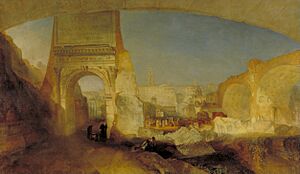
The clearing of the Forum began in 1803 with Carlo Fea, who started removing debris from the Arch of Septimius Severus. Official excavations by the Italian government began in 1898. The goal was to put broken pieces of columns and other parts back in their original places. They also wanted to dig down to the lowest possible level without harming existing structures. And they aimed to identify buildings that were only partly dug up, like the Senate house and Basilica Aemilia. These government-funded excavations were led by Dr. Giacomo Boni until he passed away in 1925, with a short break during World War I.
In 2008, heavy rains damaged the modern concrete cover over the "Black Stone" marble in Rome. Excavations in the Forum continue. Since 2009, archaeologists have made discoveries that raise questions about Rome's exact age. One recent find is a tuff wall near the Lapis Niger. It was used to channel water from nearby underground sources. Pottery and food scraps found around the wall suggest it was built in the 8th or 9th century BC. This is over a century before the traditional date of Rome's founding.
In 2020, Italian archaeologists found a sarcophagus (stone coffin) and a round altar from the 6th century BC. Experts are discussing whether it is a memorial tomb for Rome's legendary founder, Romulus.
The Temple of Saturn
The Temple of Saturn was one of the most important buildings in the Roman Forum. Not much is known about when it was first built. The original temple is thought to have been burned down by the Gauls in the early 4th century BC. However, it was rebuilt by Munatius Plancus in 42 BC. Only eight columns remain of this famous temple today. Even though its exact completion date is unknown, it is one of the oldest buildings in the Forum. The temple was originally meant for the god Jupiter but was changed to Saturn; historians are not sure why. The building was not just for religious practices. It also served as a bank for Roman society.
The Temple stood in the Forum along with four other temples: the temples of Concord, Vesta, and Castor and Pollux. At each temple, animal sacrifices and rituals were performed. These acts were meant to bring good luck to those using the temple. Since the Temple of Saturn was also a bank, and Saturn was the god of the Golden Age, sacrifices were made there hoping for financial success.
Inside the Temple, there were many vaults for the public and private ones for individuals. There were also parts of the Temple used for public speaking events and feasts, which often followed the sacrifices.
The Forum in Art
From the 1600s to the 1800s, the Roman Forum was a popular place for artists and architects studying in Rome to sketch. Many of these works by visiting artists focused on how the Roman Forum looked at the time. It was known locally as the Campo Vaccino, or "cow field," because livestock grazed on the neglected area. Claude Lorrain's 1636 painting Campo Vaccino shows how much of the Forum's buildings were buried under dirt. The famous British artist J. M. W. Turner painted Modern Rome – Campo Vaccino in 1839 after his last trip to the city.

The Roman Forum has inspired artists for centuries. Giovanni Battista Piranesi is especially famous for his 135 etchings called Vedute di Roma ("Views of Rome"), where the Forum is shown a lot. Many of the features Piranesi drew have now disappeared.
Other notable artists who painted the Forum include Canaletto, Maerten van Heemskerck, Pirro Ligorio, Giovanni Paolo Panini, and Hubert Robert.
Other Forums in Rome
Other forums existed in different parts of the city. Remains of most of them, some quite large, still exist today. The most important ones are several large imperial fora that form a complex with the Roman Forum. These include the Forum Iulium, Forum Augustum, the Forum Transitorium (also called Forum Nerva), and Trajan's Forum. During the time of Mussolini, most of the medieval and Baroque layers were removed. The Via dei Fori Imperiali road was built between the Imperial Fora and the Roman Forum. There are also:
- The Forum Boarium, which was for selling cattle, located between the Palatine Hill and the Tiber river.
- The Forum Holitorium, for selling herbs and vegetables, between the Capitoline Hill and the Servian walls.
- The Forum Piscarium, for selling fish, between the Capitoline hill and the Tiber, in the area of the current Roman Ghetto.
- The Forum Suarium, for selling pork, near the barracks of the city guards in the northern part of the Campus Martius.
- The Forum Vinarium, for selling wine, in the area now called "quartiere" Testaccio, between Aventine Hill and the Tiber.
Other markets were known, but their exact purpose or location is not clear due to a lack of detailed information.
See also
 In Spanish: Foro Romano para niños
In Spanish: Foro Romano para niños
- Colossus of Constantine, a giant statue once in the Basilica of Maxentius
- Farnese Gardens (1550), which overlook the Forum
- Veduta (a type of detailed landscape painting)
- List of tourist attractions in Rome


